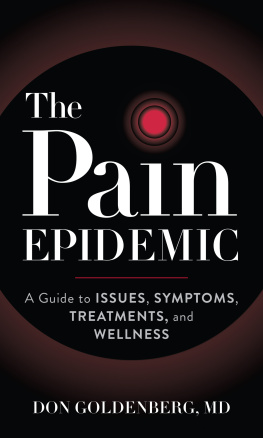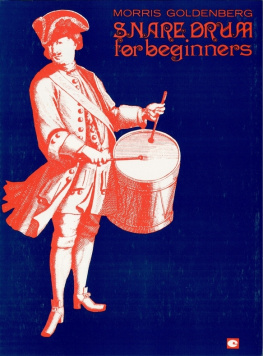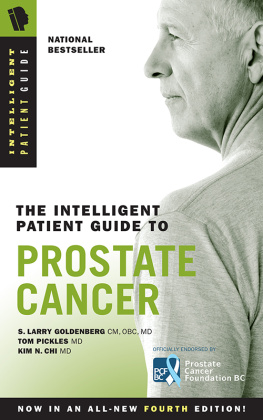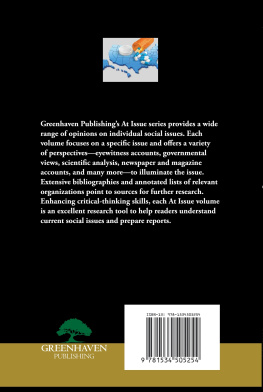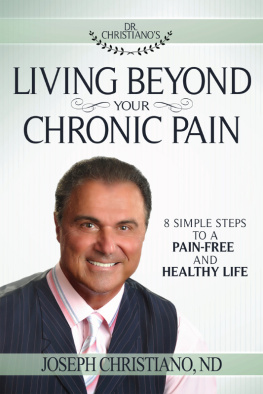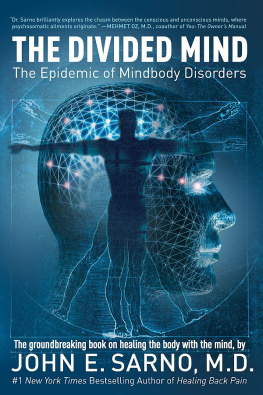Don Goldenberg - The Pain Epidemic
Here you can read online Don Goldenberg - The Pain Epidemic full text of the book (entire story) in english for free. Download pdf and epub, get meaning, cover and reviews about this ebook. year: 2012, publisher: Rowman & Littlefield Publishers, genre: Science. Description of the work, (preface) as well as reviews are available. Best literature library LitArk.com created for fans of good reading and offers a wide selection of genres:
Romance novel
Science fiction
Adventure
Detective
Science
History
Home and family
Prose
Art
Politics
Computer
Non-fiction
Religion
Business
Children
Humor
Choose a favorite category and find really read worthwhile books. Enjoy immersion in the world of imagination, feel the emotions of the characters or learn something new for yourself, make an fascinating discovery.
- Book:The Pain Epidemic
- Author:
- Publisher:Rowman & Littlefield Publishers
- Genre:
- Year:2012
- Rating:5 / 5
- Favourites:Add to favourites
- Your mark:
- 100
- 1
- 2
- 3
- 4
- 5
The Pain Epidemic: summary, description and annotation
We offer to read an annotation, description, summary or preface (depends on what the author of the book "The Pain Epidemic" wrote himself). If you haven't found the necessary information about the book — write in the comments, we will try to find it.
The Pain Epidemic — read online for free the complete book (whole text) full work
Below is the text of the book, divided by pages. System saving the place of the last page read, allows you to conveniently read the book "The Pain Epidemic" online for free, without having to search again every time where you left off. Put a bookmark, and you can go to the page where you finished reading at any time.
Font size:
Interval:
Bookmark:
The Pain Epidemic
The Pain Epidemic
A Guide to Issues, Symptoms,
Treatments, and Wellness
Don Goldenberg
ROWMAN & LITTLEFIELD
Lanham Boulder New York London
This book represents reference material only. It is not intended as a medical manual, and the data presented here are meant to assist the reader in making informed choices regarding wellness. This book is not a replacement for treatment(s) that the readers personal physician may have suggested. If the reader believes he or she is experiencing a medical issue, professional medical help is recommended. Mention of particular products, companies, or authorities in this book does not entail endorsement by the publisher or author.
Published by Rowman & Littlefield
An imprint of The Rowman & Littlefield Publishing Group, Inc.
4501 Forbes Boulevard, Suite 200, Lanham, Maryland 20706
https://rowman.com
6 Tinworth Street, London SE11 5AL, United Kingdom
Copyright 2020 by The Rowman & Littlefield Publishing Group, Inc.
All rights reserved. No part of this book may be reproduced in any form or by any electronic or mechanical means, including information storage and retrieval systems, without written permission from the publisher, except by a reviewer who may quote passages in a review.
British Library Cataloguing in Publication Information Available
Library of Congress Cataloging-in-Publication Data
Names: Goldenberg, Don L., author.
Title: The pain epidemic : a guide to issues, symptoms, treatments, and wellness / Don Goldenberg.
Description: Lanham : Rowman & Littlefield, [2020] | Includes bibliographical references and index.
Identifiers: LCCN 2020009908 (print) | LCCN 2020009909 (ebook) | ISBN 9781538138359 (hardcover) | ISBN 9781538138366 (epub)
Subjects: LCSH: Chronic pain. | Chronic painTreatment.
Classification: LCC RB127 .G653 2020 (print) | LCC RB127 (ebook) | DDC 616/.0472dc23
LC record available at https://lccn.loc.gov/2020009908
LC ebook record available at https://lccn.loc.gov/2020009909
 TM The paper used in this publication meets the minimum requirements of American National Standard for Information Sciences Permanence of Paper for Printed Library Materials, ANSI/NISO Z39.48-1992.
TM The paper used in this publication meets the minimum requirements of American National Standard for Information Sciences Permanence of Paper for Printed Library Materials, ANSI/NISO Z39.48-1992.

My personal odyssey to better understand and treat chronic pain began forty years ago. My wife, Patty, an excellent athlete and tennis player, was struck in the left eye with a tennis ball. She could not see through the blood that pooled in the outer chamber of her eye, and we worried that she might lose sight in that eye. Her treatment consisted of two weeks of complete bed rest with a patch over the injured eye. Fortunately, the eye healed and her sight was restored. However, it quickly became apparent that she was having difficulty recovering her normal health.
Patty began suffering from generalized muscle pain and exhaustion. During the two weeks of bed rest, as frequently happens to people in that situation, Patty had difficulty distinguishing day from night, and her sleep became very erratic. However, the insomnia persisted for Patty; she began waking up frequently during the night and had difficulty getting back to sleep. She described waking up feeling like a truck just ran me over. Muscle soreness and exhaustion prevented her from getting back to her regular exercise routine. Her neck and back pain were constant and accompanied by severe headaches.
In addition, she began complaining of a number of seemingly unrelated new symptoms. These included abdominal discomfort and cramping with bouts of constipation and diarrhea. Patty also experienced urinary frequency and urgency, often accompanied by bladder and pelvic discomfort.
As a rheumatologist, my first thought was that Patty had developed a connective tissue disease such as rheumatoid arthritis or systemic lupus erythematosus (lupus). These are diseases that occur most often in young women, and they often present with generalized pain and fatigue. However, when I examined her, there was no swelling around her joints, the cardinal finding in systemic arthritis. Neither was there any obvious weakness or neurologic abnormality. What I did find was a lot of tenderness almost anywhere that I probed her muscles and joints. Following the unwritten medical rule of never treating your family, I decided to send Patty to one of the more prominent rheumatologists in Boston for an expert consultation.
He ordered numerous blood tests and X-rays and told me that he also was concerned that Patty might have an immune disease, such as lupus or scleroderma. One of the laboratory tests, the antinuclear antibody, a marker for lupus, was positive. However, that test can be positive in healthy women, and all her other blood tests were normal. He treated Patty with a short course of prednisone, a corticosteroid that often works wonders in systemic rheumatic diseases. The prednisone did not help her symptoms but made her sleep disturbances much worse, which aggravated her exhaustion.
We then began a yearlong search for answers and consulted with a number of different medical specialists. A neurologist whom I greatly admired felt that Patty probably had a neuropathy. Patty underwent painful nerve conduction velocity tests to her arms and legs. The results were equivocal. A brief trial with a medication used to treat neuropathy was not helpful. We saw a new general internist, who ran a battery of blood tests and X-rays but again without finding any clues to her symptoms.
As the year dragged on, Patty and I both suspected that some of her symptoms could be related to depression. Usually cheerful and upbeat, Patty said, This is really getting to me. She had no previous bouts of depression, although both her mother and sister had a history of mood disorders. Patty had worked in my office for years, and we were both keenly aware of the intricate relationship between depression and pain and fatigue.
Just then I read a medical report on fibromyalgia. I had heard of fibromyalgia, which had also been termed fibrositis, but my rheumatology mentors had dismissed it as a wastebasket term for poorly understood aches and pains. However, this new article on fibromyalgia described every one of Pattys symptoms to a tee. It was as if I was reading her yearlong medical history. Fibromyalgia patients were most commonly women, between ages thirty and fifty. They all had unexplained generalized muscle pain and exhaustion with no evidence for a systemic inflammatory or immune disease. The article also reported that there were specific locations in the body where patients with fibromyalgia were most tender to palpation when modest pressure was applied. I proceeded to search for these on Patty and she had all of these tender points.
Over the next few days, I read every article on fibromyalgia that I could find. Pattys gastrointestinal symptoms were consistent with irritable bowel syndrome, and the urinary frequency and urgency were typical of chronic pelvic and bladder pain syndrome, both present in the majority of women with fibromyalgia. Most patients with fibromyalgia also suffered from sleep and mood disturbances and chronic headaches, as did Patty. One medical report suggested that treatment with a small amount of amitriptyline was helpful for the sleep problems and might decrease the pain of fibromyalgia. So I prescribed a tiny amount (10 mg) of amitriptyline.
Next pageFont size:
Interval:
Bookmark:
Similar books «The Pain Epidemic»
Look at similar books to The Pain Epidemic. We have selected literature similar in name and meaning in the hope of providing readers with more options to find new, interesting, not yet read works.
Discussion, reviews of the book The Pain Epidemic and just readers' own opinions. Leave your comments, write what you think about the work, its meaning or the main characters. Specify what exactly you liked and what you didn't like, and why you think so.

